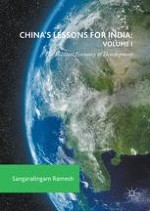2017 | Supplement | Buchkapitel
2. An Economic History of India
verfasst von : Sangaralingam Ramesh
Erschienen in: China's Lessons for India: Volume I
Aktivieren Sie unsere intelligente Suche, um passende Fachinhalte oder Patente zu finden.
Wählen Sie Textabschnitte aus um mit Künstlicher Intelligenz passenden Patente zu finden. powered by
Markieren Sie Textabschnitte, um KI-gestützt weitere passende Inhalte zu finden. powered by
